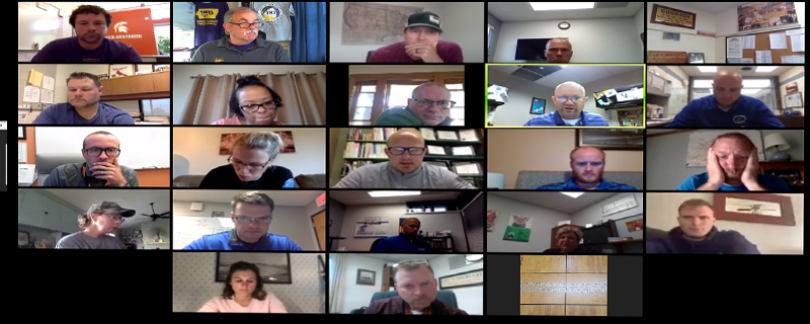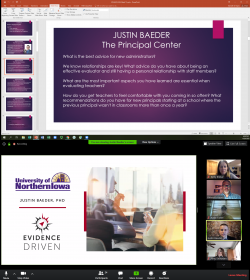Learning Goes Remote
 A switch flipped on March 23 at University of Northern Iowa and the College of Education, as education went remote. For some, the transition was sudden; for others, even seismic. Perhaps not fully satisfying, but necessary. And, here and there, an experience that represented opportunity.
A switch flipped on March 23 at University of Northern Iowa and the College of Education, as education went remote. For some, the transition was sudden; for others, even seismic. Perhaps not fully satisfying, but necessary. And, here and there, an experience that represented opportunity.
For Elana Joram, professor, educational psychology, foundations and leadership studies, it pushed her into unfamiliar territory. And as was common, she had help.
“I had been toying with the idea of having Zoom meetings but wasn’t sure because I’d never tried it,” she recalls. She first met with Farah Kashef, an educational technologist who works out of the HNI Instructional Resource and Technology Center, to learn the basics. She then asked colleague Kenneth Hayes, an instructor in EPFLS, for some tips.
“We met virtually, and he walked me through some very basic aspects – what to say to students at first, how to bounce in and out of breakout rooms, etc. Especially helpful was his modeling of what he would typically say and the procedures he used in his virtual classes," says Joram. "Thanks to Farah and Ken, I felt very prepared for my first virtual class. The students seemed to really enjoy having the contact, and the sense of normalcy.”
Hayes’ advice to Joram was heard by many during the transition: “Give yourself grace. It’s a big learning curve here. Don’t be afraid to reach out to us (your colleagues) for assistance. Don’t default to ‘online’ only -- use Zoom. There is nothing like ‘real time’ connections that make this transition smoother and your class richer.”
New tools for many
Zoom, Panopto, Blackboard--these were tools that were less or more familiar to some. With plans to go to fully remote learning, the university  Information Technology team went into action. A comprehensive remote learning webpage--with information and resources specific to faculty, staff and students--went up quickly and was part of the uni.edu/prepare COVID-19 informational site. Online workshops were added, and IT became a hub for information, assistance and equipment check-out.
Information Technology team went into action. A comprehensive remote learning webpage--with information and resources specific to faculty, staff and students--went up quickly and was part of the uni.edu/prepare COVID-19 informational site. Online workshops were added, and IT became a hub for information, assistance and equipment check-out.
“The communication and collaboration between IT and faculty/staff were prompt and strong. The teaching had to continue and that was our prime focus. Many faculty continued teaching ‘face-to-face’ via Zoom, and many switched to a hybrid format using Zoom synchronously, and other tools such as Blackboard or Panopto to teach asynchronously,” Kashef says.
She saw her workload double right after spring break. As a member of the UNI information technology and educational technology media services (IT-ETMS) team, she is dedicated to the College of Education but supports the overall campus, where the educational technologist to faculty ratio at UNI is almost 3:697.
“I have to admit, I am so proud of the College of Education's faculty. They were prepared to face this challenge. They are also comfortable reaching out and asking questions. They are incredibly advanced when it comes to educational technology and when the campus closed, they quickly came up with creative ways to keep teaching,” she says, noting from March 23 to May 12, her five-person team responded to 532 requests for assistance, with 20 percent coming from the College of Education. “I connected with them from home via Zoom, Service Hub, and email. What I found to be helpful for the faculty, besides the Zoom meetings, were the recorded workshops or the recorded personalized how-to videos I made on the spot.”
Getting started
The first week going remote was a challenge, but a beginning. “If I could summarize the first week into one word it would be preparation,” says Melissa Stueve, an instructor in athletic training. “I found myself figuring out how to use Zoom, how I was going to teach a hands-on upper extremity evaluation course, and preparing supplemental assignments for observation students. Our first two Zoom labs went better than expected.”
Mauricio Nunez, kinesiology, converted his PEMES 3151 lecture to a live video feed. “The students seemed to respond well to this the first week and in all three sections about 95% of the students logged in and participated,” he says.
“I was impressed by how well my students adapted to online learning. Every class period I saw students who worked deeply and collaboratively with their peers on authentic problems of classroom practice,” says Ron Rinehart, associate professor, EPFLS, referencing the shift for his Learnings and Motivations course.
“One shift we made was toward collaborative reasoning and writing. In my experience learning to write well is preceded by learning to reason well. Since moving online, students had unprecedented access to each other's reasoning via our collaborative writing. Students worked in small groups to use their knowledge of theories of motivation and learning to analyze problems of practice and then evaluate each other's solutions to these problems. This promotes metacognitive discussions that are rich in higher-order thinking.
“I found that meeting face-to-face on Zoom, and making sure that we have a positive classroom atmosphere, provides some social and emotional stability during times of change,” he adds.
Opportunity, with challenge
The emphasis on remote learning yielded opportunity as well. Faculty foresaw future tweaks to the curriculum, incorporating their “on the fly” learnings and resources uncovered. Student teachers focused on remote learning in classrooms in seminar discussions and projects to better prepare for their future in K-12 schools. The flexibility to join in classroom discussion or departmental planning wearing pajamas or jeans or while walking the dog had its pluses. Among faculty, this unexpected shift led to increased collaboration and communication.
“One lesson learned is the need for frequent, focused, and direct communication with faculty and staff. I held both weekly practicum/field-based Zoom meetings with agenda [both my agenda items as well as those solicited from the faculty], as well as weekly ‘touch base’ meetings for the entire faculty and staff, with planned topics and discussions,” says Susan Etscheidt, head, special education. “These weekly Zoom meetings provided a needed forum for communication and fostered a sense of collegiality and community.”
Student perspectives
A fully online campus was not the plan as the semester started--nor was it the desire as the semester ended. In part, that was due to the additional variables that faculty, staff and students were navigating: balancing work and family, the shift of formal and informal K-12 education to parents at home; limited child care options; students moving home; job loss for many, while others remained in essential part-time positions.
In a survey of students (see “Survey Says…”), students acknowledged difficulties in this transition for everyone, while pointing out areas for room for improvement as UNI prepares for a return to class this fall. Among the open-ended comments:
“I think that while it was a challenge for everybody we came through. Personally my professors have adapted very very well to the change. Overall, I think that this just shows how much face-to-face interaction with classmates and instructors was undervalued by myself and many other students.
“It was difficult, but I know that it wasn't just difficult for me, it was difficult for students and professors, so we were all learning together. I definitely do not prefer this kind of learning, I would MUCH rather be in a classroom.
“My program is almost entirely online but the stress of working full time from home, taking care of children fulltime and adjusting some of my coursework is extremely overwhelming.
“Teachers have tried everything they can to help me continue to learn, and you can tell they are all trying their very best. I am very thankful for all the support our teachers have given us.”
“I think many professors have realized that they have to really engage us for us to come online.”
Graduate programs adjust as well
Graduate students who earn their degrees in conjunction with programming offered through UNI Continuing and Distance Education did not experience as big a shift this spring (outside of balancing everything else going on with work and family).
However, some graduate programs are fully face-to-face, while other distance education programs are a hybrid. Each summer, educational leadership faculty welcome a new cohort of principalship candidates during a two-day orientation on campus. This year Hayes has crafted a virtual welcome for the July introduction.
Similarly, the hybrid superintendency program is primarily online, but with two two-day sessions on campus each summer for two cohorts. Students look forward to the face-to-face interactions with UNI faculty and current superintendents, or “critical friends” within the program. This year they will connect via Zoom instead.
Denise Schares, associate professor, conducts a series of leadership camps as part of the Institute for Educational Leadership. Schares was able to package existing materials into 15 modules which are self-paced, particularly important for participants who are working through their own return to school planning for their school districts.
“After the initial discomfort of seeing and hearing myself on the recordings, the modules went together easily and the website was created,” Schares says. “The difficult part is not being together for the conversation, but participants indicate they were able to have the recommended conversations with other leaders in their districts or family members. We are very hopeful that we can return to face-to -face delivery for fall, but we’re making the best of uncertain times.”
